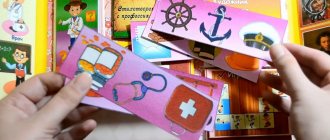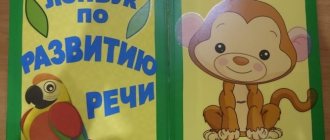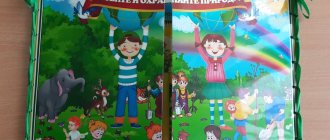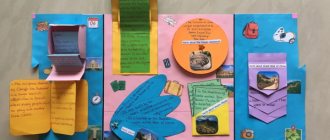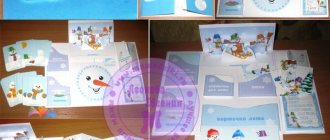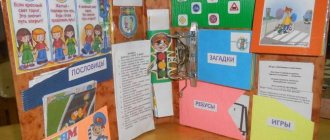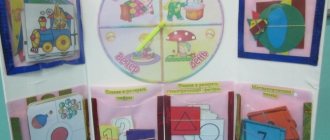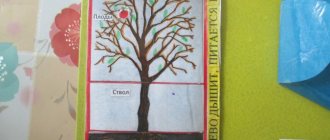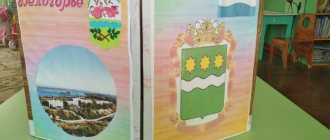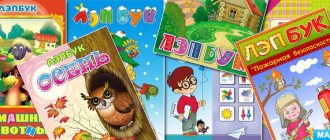Who develops the manual
The author of a lapbook is usually a teacher. But if for younger preschool age the teacher is involved in both the selection of material and its design, then in the middle group parents can get involved in the design and search for information.
For example, in my practice, as part of the discussion of the topic “Professions,” I give students and their parents a project task to write a story about the professions that we cannot do without. Or compile a manual with pictures, riddles, games dedicated to one profession.
In older preschool age, children take an active part in the selection of materials for designing a lapbook: they find illustrations, cut them out, and glue them. As in the middle group, mothers and fathers are actively involved in the search for materials, for example, they compose crosswords, puzzles on the topic, or collect a “data bank” about the professions of the future (city farmer engaged in landscaping megalopolises, developer of home robots, etc.).
Parents and children can offer materials for a group lapbook, and the teacher selects the most suitable and necessary information on the topic
How the “Professions” lapbook is developed
There are no restrictions on the flight of creative thought when preparing a manual; there are only a number of subtleties identified experimentally:
- the manual must be strong, as it is intended for active use, which means it is better to choose plastic folders or hard cardboard (for example, from packaging household appliances) for the base;
- materials - cards, pictures - must be laminated or covered with tape;
- pockets for storing materials must be firmly attached to the base (with glue or double-sided tape);
- the contents of the lapbook can be organized with separate cards, folding books or a window with a retractable tape (for example, for the game “Tell me what you want to become” - the child moves the tape and an image of a particular profession appears in the window, which needs to be told about and commented on whether the child would like to become a specialist in this profile).
As for the content of the manual, it must comply with the program material on the topic “Professions”, as well as the requirements of the Federal State Educational Standard regarding the knowledge, skills and abilities that children of a particular age should possess.
Table: nuances of choosing the content of “Professions” lapbook blocks in different groups
| Material block | Why is it included in the manual? | Peculiarities of consideration in different groups |
| Informational | To familiarize yourself with the topic. The information block is the basis of the manual, on which the rest of the materials are focused (visualization, games, etc.) | In the first junior group, children get acquainted with professions, with the results of the work of specialists that they encounter in everyday life: a cook prepares food in kindergarten, a driver drives the bus on which mother goes to work, a doctor treats if they are sick. |
| In the second junior group, children expand their knowledge about a person’s occupation (teacher, hairdresser, accountant, etc.), and also consider the topic in the context of the professional occupations of their loved ones (“My mother is a teacher,” etc.). | ||
| In the middle group, children learn to correlate a profession with the tools and materials that are needed for specialists in this profile (a car for a driver, a pointer for a teacher, a white coat, medicines, a phonendoscope for a doctor, etc.). | ||
| In the senior group, children form a generalized concept of “profession”, expand their ideas about labor actions, about specialties that were, are and will be relevant in the world. | ||
| In the preparatory group, children generalize their existing knowledge, and also form primary ideas about the importance of choosing a profession in a person’s life, and get acquainted with the professions of the future. | ||
| Literary (stories, poems) | To form images of professions, instill respect for work. | Younger preschoolers can be introduced to the topic with the help of “Tales of Missing Professions,” which focuses on the importance of having specialists in each field, as well as by drawing on excerpts from K. Chukovsky’s work “Doctor Aibolit.” |
In the middle group, you can include the poem “What do you have” by S. Mikhalkov in a lapbook, building on its basis a conversation on the topic “Why the professions of our mothers and fathers are important”:
| ||
For older preschoolers, the selection can include:
| ||
| Puzzles | To consolidate and repeat material. | In early preschool age, it is better to select tasks with rhyming answers, since it is still difficult for children to work with the “classic” version of riddles. For middle and older students, this block includes riddles about things directly related to the profession. |
| Visual | To add aesthetics to the manual and better assimilation of the material. In addition, the manual includes cartoons on the topic. | In the younger group, the visual block includes pictures depicting representatives of different professions to illustrate the teacher’s stories; in the second youngest group, the kids themselves describe the pictures in 3-4 sentences. In the middle group, based on the pictures, children compose a generalized story about the profession in 4–5 sentences, and in the older groups they supplement the story with their opinion regarding a particular specialty, try to imagine how our life would change without this profession (in 6–8 sentences) . |
| Creative (coloring, sculpting) | To consolidate materials, develop creative abilities and expand cognitive interests. | In early preschool age, children work with pictures that do not have a lot of details. In the middle and senior groups, children paint specialists in the surroundings of their professional activities (a doctor examining a patient, a teacher in a lesson). Starting from the middle group, this block can include step-by-step instructions for modeling on topics related to professions. |
| Block with puzzles and crosswords | To work with this block, children need to have an understanding of letters and also be able to write, so it is used only in lapbooks for older preschoolers. For toddlers and middle preschool children, you can use “Find the Differences” pictures. |
Video: cartoon presentation of professions for younger preschoolers
Video: cartoon “In the world of professions” for preschoolers
Lepbook for older children on the topic “Professions”
Lapbook “Professions”
Annotation:
The didactic manual lapbook “Professions” is a cardboard folder covered with paper. On the pages of the folder there are various pockets and cards that contain information on the topic.
Explanatory note:
This lapbook is intended for children of senior preschool age and is a developmental learning tool. The lapbook “Professions” can be used to organize joint work between a teacher and children, as well as for independent collective activities of children and independent individual activities of a child. The theme of the lapbook allows you to design it during the “Professions” themed week. The content of the laptop can be expanded and complicated. At older preschool age, children can already participate in the collection of material together with adults: analyze, sort information, and participate in the design of games. This laptop can be used by preschool teachers and speech therapists.
Purpose of the laptop:
expand and generalize children’s understanding of professions, tools, and labor actions.
Tasks:
Educational
-help children understand the importance and necessity of each profession;
— to form a consciously correct attitude towards work.
Educational:
- develop interest in various professions;
- develop coherent speech, thinking, attention, imagination, memory;
— develop children’s cognitive and creative abilities; fine motor skills of the hands.
-develop communication skills;
Educational:
- develop cooperation skills and independence;
— cultivate respect for the work of adults.
Expected Result:
- to arouse interest in the surrounding world;
- to expand children’s knowledge and ideas about professions, including the professions of their parents (parents’ place of work, the significance of their work; pride and respect for the work of their parents);
Contents of the laptop “Professions”
1. Pocket “Who to be” - game - lotto.
Purpose of the game: to supplement and generalize children’s knowledge about professions and attributes necessary for each profession.
Rules of the game:
The presenter (teacher) mixes the fields and cards and gives each player one field, and places the cards in a separate pile with the text down. Then he takes the top card from the pile and reads the text of the riddle on it out loud. If the player who has a picture on the field depicting a representative of the profession this riddle is about, names it, then the presenter gives him this card. The player places a card on a section of his field. If the player has not solved the riddle, then the leader places this card at the bottom of the pile. The first one to cover all the areas on his field is declared the winner.
2. Pocket “ABC of professions” - cards with text about professions
and pictures depicting a representative of the profession.
3. Pocket “Let’s think!” - task cards
on logic, attention.
Goal: development of logical thinking, training of attention, memory, imagination.
4. Pocket “Who needs what” - game - lotto: expand and secure
knowledge about professions and the objects of their work.
Goal: systematize knowledge about professions; about the objects of their labor.
5. Pocket “Jolly Clown”: let’s make a clown.
6. Pocket “Games with letters” - cards with names of professions for
exercises to develop sound analysis and synthesis, to consolidate counting.
Tasks: how many letters are there in a word, show the letter from the word (O, (A).
7Pocket “Assemble a picture” - cut-out pictures: compiling
a plot picture made up of parts, tell who is depicted in it.
8. Pocket “Pick a diagram” - pictures depicting representatives of the profession. Syllabic schemes of words: exercises to develop the skills of syllabic analysis and synthesis, phonemic representation: we determine the first and last sounds in words, select words for given sounds.
9. Pocket “Finger games - exercises for speech development, coordination of movements, development of fine motor skills.
10. Pocket “Give me a word” - exercises for speech development.
11. Pocket “Coloring Books”
12. Pocket “Descriptive story diagram” - cards with images of representatives of professions, descriptive story diagram: we compose a story about the profession based on the picture or about the profession of the parents.
For joint activities of a child and an adult, the following materials are provided: the game “Who to be?”, “ABC of Professions”, Finger Games”, “Say a Word”
A selection of materials for the laptop “Professions”
When choosing materials, the teacher is guided by the program, the Federal State Educational Standard and the level of development of children in a particular group.
Information block
As text to illustrate thematic pictures, you can use descriptions of modern professions (Teacher, Manager, Hairdresser, etc. and Accountant, Cook, Seller, etc.). And for older preschoolers, it is worth including information about the professions of the future in the lapbook.
To summarize professions by area of application, you can make a “Profession Country Map”, distributing specialties in several areas: “City of Services” (hairdresser, salesman, etc.), “City of Knowledge” (scientist, teacher, etc.), etc. Based on the description of each city, children lay out pictures depicting the corresponding specialists.
The guys write a separate story-description about each “city”
To facilitate the task of telling about a profession using a picture, children in the middle and older groups can be offered a visual plan.
A plan with illustrations helps to create a story about the profession even for those who cannot yet read
Poems
In a block with rhyming for younger preschoolers you can include:
- Give the cook the food: Poultry, dried fruits, Rice, potatoes... And then delicious food awaits you.
- In the morning the sun shines brightly, the milkmaid carries the milk. Warm, cow, good for children's health.
- Give me scissors and a comb, He will do your hair. The hairdresser will certainly give you a modern haircut.
- A hammer is needed for work, and a carpenter is friendly with a saw. He sawed the planks and made a birdhouse.
For middle and senior preschool age, a selection can be compiled based on materials from the collection published here.
Puzzles
Rhymes with “agreements” about professions are usually included in the manual for the middle group, but in a lapbook for kids it can be used in fragments.
For middle and older groups, the selection can also include riddles about tools:
- He sews everything in the world. What he sews, he doesn’t put on (Needle);
- I run along my bald head - I cut the curls from my bald head (Plane);
- A lot of friendly guys are sitting on one pillar. As they begin to frolic - Only dust swirls around (Broom).
Riddles dedicated to specific professions can be found here.
Proverbs, sayings
A lapbook for middle and older age should include proverbs and sayings about the importance of work:
- The craft does not hang behind your shoulders.
- The cook is always full of spirit.
- The cook lives better than the prince.
- It will be a disaster if the shoemaker starts baking pies.
- You won't get bread by self-indulgence.
- Not all chefs have long knives.
Game block
This block can include all types of games in the form of a brief description of the conditions or a selection of visual materials.
Table: examples of games for the “Professions” laptop
| What is the name of the game | The essence | Which age group is it aimed at? |
| Didactic games | ||
| "Clap your hands if..." |
| To the second youngest |
| "Correct the mistake" | The teacher says a phrase, and the children correct the mistake:
| To medium |
| "Continue the sentence" | The teacher begins the phrase, the children finish:
| For seniors |
| Theatrical | ||
| "Let's show how it is" | Children are offered a list of situations that they act out in skits:
| |
| “We won’t tell you where we were, but we’ll show you what we did.” |
| For middle, senior |
| Outdoor games | ||
| “All professions are important” (for the gym) | The teacher describes the profession, the children perform the following movements:
| For seniors |
| Examples of finger games on the topic “Professions” can be found in the publication of N.V. Kochetkova. | ||
Photo gallery: puzzles, crossword puzzles and “Find the Differences” themed pictures for the “Professions” lapbook
Answers: stylist, cook, steelworker, astronomer, miner, understudy, livestock breeder, journalist, gold miner, archer, spooner, crabber, mower, cattle breeder, crusader, carpenter, key holder, spy
By solving a crossword puzzle, children practice their knowledge of letters
Answer: postman
Children need to find 5 differences in pictures with fishermen
In these pictures the guys are looking for 5 differences
Children need to find 10 differences in these pictures.
Photo gallery: templates for coloring and instructions for modeling on the topic of profession
An additional task for the Chef's coloring book could be to come up with a story about what he cooks
Despite the number of small details, even kids can color the ballerina: filling with color is only necessary for the ballet tutu
The coloring book of a Builder with a fragment of a brick wall can be used already in the second junior group to practice accurate coloring of masonry rectangles
When considering the profession of a hairdresser, it is important to emphasize that both women and men can engage in this activity
When considering a topic related to a person’s professional development, it is worth paying attention to specialties that for many are a hobby, in particular photography
Based on the “Seamstress” coloring book, you can invite children from the preparatory group to reflect on the relevance of this profession in the future
Among the important professions that we cannot do without, we definitely need to pay attention to those that are related to saving people’s lives in extraordinary situations
When considering the topic “Professions of the Future”, it is necessary to mention the profession of a scientist
To add brightness to the image of the Artist, you can use wax crayons for coloring
In the older group, children can work with the modeling instructions on their own; no explanations from the teacher are needed.
MAGAZINE Preschooler.RF
THEMATIC BOOK - LAPTOP AS A MEANS OF INTRODUCING PRESCHOOL CHILDREN TO THE WORLD OF ADULT PROFESSIONS.- Yulia Aleksandrovna Korkhova - teacher, joint venture kindergarten "Topolyok" GBOU secondary school No. 8 p.g. t. Alekseevka city Kinel, Samara region
- Zanina Lyubov Viktorovna - teacher. JV kindergarten "Topolek" GBOU secondary school No. 8 p.g. t. Alekseevka city Kinel, Samara region
In connection with the implementation of the Federal State Educational Standard for preschool education, every teacher is looking for new approaches, ideas, forms and methods in their teaching activities that would be interesting to preschoolers and would be appropriate to their age, and would most effectively solve pedagogical, educational and educational problems.
Today we want to introduce you to an interesting way of organizing both educational and independent activities of children, with an interesting teaching aid - a lapbook.
What is a lapbook? Lapbook is a relatively new tool from America and is one of the varieties of the project method. Tatyana Pirozhenko adapted it to our mentality. She developed this technology for activities with her child and suggested using it in research work with children.
“Lapbook” - literally translated from English means “knee book” , or a thematic interactive folder, a collection of small books with pockets and windows that make it possible to place information in the form of drawings, small texts, diagrams and graphs in any form and on any topic. This is a book that the teacher, together with children and parents, collects, glues its individual parts into a single whole, and creatively designs it using all kinds of colors and shapes. The main thing is that the laptop is sized to fit on your lap.
A laptop is a game, creativity, learning and exploring new things, repeating and consolidating what has been learned, systematizing knowledge and simply an interesting type of joint activity between an adult and a child.
In our opinion, a lapbook in working with preschoolers is not just a form of organizing educational and educational material on a specific topic, but rather a teaching tool, since the design of a lapbook is the final stage of the independent research work that the child has done while studying this topic.
The interactivity of the folder is ensured by a variety of moving parts: accordion books, pockets, arrows, movable disks, unfolding pages, mini-books, etc. In itself, the design, production and design of a lapbook (naturally with differentiated help from an adult) contributes to the development of constructive and visual skills in a child.
Why do you need a laptop?
- It helps the child organize information on the topic being studied at will and better understand and remember the material.
- This is a great way to review what you've learned. At any convenient time, the child simply opens the laptop and happily repeats what he has learned, looking at the book he made with his own hands.
- The child will learn to independently collect and organize information.
- Creating a lapbook is one of the types of joint activities between an adult and a child.
Lapbooks can be either individual or collective (paired, group). Working individually, one child (with the help of an adult, teacher or parent) searches, collects information and prepares his work independently, relying only on himself and his own strength.
From the point of view of a child’s socialization in society, an important form of work is interaction in a small group, when 3–5 children work on one laptop. This form of organizing children is quite labor-intensive for the teacher, although it is very effective in developing children’s skills to interact with peers in a microgroup.
Creating a group lapbook allows the teacher to organize interesting cognitive interaction with the children of his group for a long time (week), since working on a lapbook (from its design to its implementation) is a labor-intensive process in terms of content and time-consuming.
When creating a collective lapbook, it is important for the teacher to correctly distribute the work with children on its individual parts and elements. It is better to make a collective lapbook in a larger format, for example A3.
Stages of working on a laptop:
- Choosing a topic, motivating children to work on a laptop;
- Joint drawing up of a plan (content) for a laptop;
- Layout development;
- Step-by-step creation of a laptop.
In our opinion, this work should begin by making a lapbook using ready-made templates that can be found on the Internet. Once children and adults have experience making them, they can begin to develop their own custom lapbooks.
Lapbook themes can be very diverse.
Lapbooks on specific (narrow) rather than general topics work best. For example, you can make a lapbook “Professions” . But it will turn out to be an overview - it is unlikely that you will be able to reflect all the diversity of the topic in the limited volume of the thematic folder. But a lapbook, for example, “Profession of a cook,” will allow you to collect more detailed information and make the lapbook as productive as possible.
It is very important to remember that if a lapbook is dedicated to career guidance, then it must meet the requirements of a systematic approach to the ideas of preschoolers.
In addition, the lapbook contains materials aimed at the speech development of a preschool child: proverbs and sayings, short poems and stories, word games; artistic and aesthetic development: illustrations, reproductions, homemade puzzles and cut-out pictures; physical development: description of outdoor games, physical exercise patterns and much more.
It is better to select materials for making a lapbook of different colors and textures in order to make the lapbook visually more attractive for a preschool child.
The most important rule for adults: it is not enough for a child to know about the profession, he needs to play it! During the game, preschoolers begin to reflect the content of the activities of representatives of various professions.
We decided to start introducing children to the world of adult professions with the profession of Confectioner. This profession is familiar and interesting to children from childhood, seeing how their mothers and grandmothers cook.
For this purpose, we made a lapbook “Profession Confectioner”. All the constituent elements of the lapbook are united by a common theme. Our laptop has 19 pockets.
Two pockets with the text of a conversation about the profession of a pastry chef. The third pocket with an introduction to confectionery equipment, the fourth pocket with the didactic game “I am a pastry chef” (cake decorating).
The fifth pocket is a collection of poems on the profession, the sixth pocket is with riddles about the items needed by the pastry chef, food, vegetables, fruits and proverbs.
The seventh pocket is with the game “Confusion” (find confused objects), the eighth is the game “What’s extra?”, the ninth pocket is with recipes (technology for preparing confectionery products). Two small pockets with coloring books, the twelfth pocket with the game “Recognize an object by its silhouette.” On the reverse side, there are two pockets with the games “Which picture is hidden” and “Paper housewife”. The fifteenth pocket with physical education and finger games. The sixteenth pocket with pictures for composing a story. Seventeenth pocket with logical tasks. Two small pockets with puzzles (dishes and confectionery).
In the course of our work on creating a lapbook, we consolidated and expanded children's knowledge about the profession of a confectioner. With the help of our manual, children, both in joint and independent activities, can extract information about the work processes of the pastry chef, as well as familiarize themselves with the objects of the pastry chef’s assistants (dishes, special equipment); can develop curiosity, interest in this profession and cultivate a respectful attitude towards the work of people in this profession; can develop the ability to use means of communication with peers and adults in order to obtain the necessary information ( “Socio-communicative development” , “Cognitive development” , “Speech development” ).
Literature:
- Gatovskaya, D.A. Lapbook as a learning tool in the conditions of the Federal State Educational Standard [Text] / D.A. Gatovskaya // Problems and prospects for the development of education: materials of the VI international. scientific conf. (Perm, April 2015). - Perm: Mercury, 2015. P. 162 164.
- Kuraev, G. A. Age psychology [text] / G. A. Kuraev, E. N. Pozharskaya. Rostov-on-Don: Phoenix, 2002. 146 p.
- Nosova, E. Yu. Using a thematic folder (lapbook) in organizing educational activities for preschool children / Nosova, E. Yu., Fedorova T. V. // Young scientist. - 2022. - No. 15. 2. - P. 136138. -
- This is interesting! [Electronic resource]. - Access mode:
- Rykova A. What is a lapbook? [Electronic resource]. - Access mode:
- Federal State Standard of Preschool Education [Electronic resource]. —
| Next > |
How to use a lapbook in kindergarten and at home
The manual is universal: it can be used in classes both in kindergarten and at home. Lapbook is convenient:
- to present new material on the topic;
- to practice acquired knowledge;
- for consolidation and repetition of material.
Based on the directions of use of the manual, we can conclude that an entire lesson can be built on its basis: update knowledge on the topic with poems, use knowledge in practice by solving riddles, playing, and consolidate the material covered by solving puzzles, solving crosswords and coloring.
Children can work with a lapbook both independently and in a group.
Using lapbooks in the work of a kindergarten teacher
Lapbook – literally translated from English means “knee book” (lap – knees, book – book). This is a homemade paper book with pockets, doors, windows, and movable parts that a child can take out, rearrange, and fold at his own discretion. It collects material on a specific topic. This is the final stage of the research work that the children did while studying this topic.
The laptop meets the requirements of the Federal State Educational Standard for preschool education:
- multifunctional: promotes the development of creativity and imagination.
- suitable for use by a group of children at the same time (including with the participation of an adult as a playing partner);
- has didactic properties, contains ways of becoming familiar with color, shape, etc.;
- is a means of artistic and aesthetic development of the child, introduces him to the world of art;
— variable (there are several options for using each part);
— its structure and content are accessible to preschool children;
— provides playful, educational, research and creative activity for all pupils.
The value of a laptop for a teacher
Promotes:
- organizing material on the topic being studied within the framework of comprehensive thematic planning;
- registration of the results of joint project activities;
- organizing individual and independent work with children.
The value of a lapbook for a child
Promotes:
- understanding and remembering information on the topic being studied;
- the child’s acquisition of skills for independently collecting information on the topic being studied;
- repetition and consolidation of material on the covered topic
Lapbook topics can be: children's hobbies; topics of the week; literary works; interesting events.
The content of the laptop is educational games, riddles, poems, coloring pages, pictures, photographs dedicated to one topic.
I bring to your attention the lapbooks that I use in working with children of middle and senior preschool age.
Lapbook “Trees of our region”
The lapbook contains “Magic circle - Which tree is the leaf from”, coloring pages on the theme, poems and riddles, a diagram “Tell me about a tree”, cards “Who are trees for”, “What is made of wood?”, “How to behave correctly” In the woods".
Lapbook “My country is my Russia”
The lapbook contains photographs of famous people of Russia, the game “Collect the flag and coat of arms”, the game “Memo” with the sights of Moscow, a quiz and puzzles
Lapbook “My Dzerzhinsk”
The lapbook contains a walking game “Travel around your hometown”, a game “Memo” with the sights of the city, pictures “Rastyapin’s fun”, a game “Collect a coat of arms and a map”
Lapbook “Visiting the whistles”
The lapbook contains articulation gymnastics, riddles, coloring pages, sayings, sound snails, mnemonic tables with sayings, sound walkers, and a breathing game “Blow a Snowflake”
Lapbook “The Big Guy”
The lapbook contains cards with healthy and unhealthy foods, coloring pages, emoticons and teeth for evaluating foods, routines, clothes, the game “Merry Men,” and a visual simulator.
Lapbook “Visiting Fairy Tales”
The lapbook contains coloring pages based on fairy tales, a theater on spoons, a finger theater “Zayushkina’s Hut”, a game “Name a fairy tale”, “Collect a fairy tale”, “Lay out a fairy tale”
A laptop helps: structure complex information; develop the child’s cognitive interest and creative thinking; add variety to even the most boring topic;
teach a simple method of memorization, unite the whole family (a group of children in kindergarten) for a fun and useful activity
